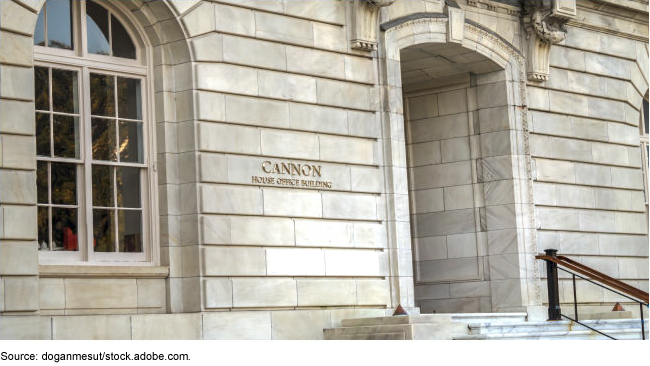Architect of the Capitol: Efforts Have Begun to Update Cannon House Office Building's Renovation Cost and Schedule Estimates
Fast Facts
For nearly 7 years, the Architect of the Capitol has been renovating the 113-year-old Cannon House Office Building to maintain its character, fix deterioration, and improve it for Members and staff.
We testified on project status and cost estimates as part of our assistance with congressional oversight.
The Architect of the Capitol:
- Substantially completed 3 of 5 planned project phases
- Increased the cost estimate to $890 million after a risk mitigation analysis in December 2019
- Plans to update its cost estimate after a December 2021 analysis to include new risks such as COVID-19, the January 6th attack, and security for the Inauguration
The Cannon House Office Building

Highlights
What GAO Found
The Architect of the Capitol (AOC) has substantially completed three of five planned phases to renovate the Cannon House Office Building (Cannon project). AOC completed Phase 0 utility work; the Phase 1 work to renovate the building's west side, the Phase 2 work to renovate the building's north side; and work is underway on Phase 3 of the building's east side.
Cannon House Office Building, Washington, D. C.

From 2009 to 2018, AOC consistently estimated the project cost at $753 million, In 2014, GAO found that AOC's cost estimate of $753 million reflected several of GAO's leading practices for high-quality, reliable cost estimates, including that AOC had conducted a risk and uncertainty analysis. GAO found that AOC's cost estimating policies and guidance did not require a quantitative risk and uncertainty analysis nor the reporting of the resulting confidence level of the estimate. GAO made recommendations for AOC to incorporate leading practices into agency guidance and submit confidence levels of cost estimates to Congress. AOC implemented our recommendations. In January 2018, AOC updated its analysis of risks by undertaking an integrated cost-schedule risk analysis. AOC's 2018 analysis arrived at the same conclusion as its earlier analysis—that the project's estimated $753 million total cost was adequate to complete the project. However, AOC's 2018 analysis indicated that inaccurate estimates of costs for risk mitigations, unknown risks, and optimistic assumptions about the effect of risk mitigations on the project's cost and schedule could affect its total cost. AOC updated the analysis in December 2019 and estimated the project cost at $890 million.
Two unknown risks materialized after the December 2019 estimate: the effect of COVID-19 and the January 2021 security events–their impact on the project is uncertain. In its March 2021 project summary, AOC reported that a revised budget would be formulated after the completion of an analysis in December 2021. Toward this end, in May 2021, AOC began updating its integrated cost-schedule risk analysis, with the aim of more accurately determining the extent to which the project's costs are increasing and its estimated cost at completion.
Why GAO Did This Study
In its Cannon project, the AOC intends to preserve the historic character while improving the functionality of the 113 year-old Cannon Building—the oldest congressional office building—as well as address deterioration to the building and its components. The project—nearing year 7 of its planned 10-year duration—is being implemented in five sequential phases with an initial phase (Phase 0) for utility work and four subsequent phases (Phases 1 through 4) to renovate the north-, south-, east-, and west-facing sides of the building. Each phase is scheduled around a 2-year congressional session.
This statement describes: (1) the status of the Cannon project and (2) changes to the project's estimated cost at completion. This statement is based on GAO's prior reports in 2009 and 2014 and ongoing monitoring of the project. To monitor the project, GAO has been observing the ongoing construction, attending project meetings, and analyzing AOC documents.
Recommendations
In 2014, GAO made recommendations pertaining to AOC's cost-estimating guidance and policies. AOC has implemented these recommendations.
